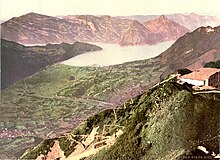Stans
Stans (German pronunciation: [ʃtans]) is the capital of the canton of Nidwalden (Nidwald) in Switzerland.
[3] During the Roman era there is little evidence of a settlement except for some Gallo-Roman Ustrinum or funeral pyres and the Latin root (stagnum meaning a pool or sump) of the name Stans.
In 1386, during the Battle of Sempach, a soldier from Stans, Arnold von Winkelried, is claimed to have thrown himself on the pikes of the Habsburg army which led the Swiss to victory.
The details of the message have remained unknown to this day, however it did calm the tempers and led to the drawing up of the Stanser Verkommnis.
In 1798 Stans was stormed by French troops, following the decision of Nidwalden not to adopt the constitution of the Helvetic Republic.
Children orphaned by this event were gathered by the educator Johann Heinrich Pestalozzi for his first school.
[5] In 1814, following the collapse of the Napoleonic Act of Mediation, Nidwalden attempted to return to the Ancien Regime government, with subject lands belonging to the canton.
Stans and the rest of Nidwalden only gave up their subject lands when Federal troops marched into the city.
In 1964 the Lucerne-Stans-Engelberg rail way was opened and in 1966 the A2 motorway (which is Switzerland's main north–south axis from Basel to Chiasso) was constructed.
The wettest month is August when Stans receives an average of 166 mm (6.5 in) of precipitation on 13.6 days.
From the peak of the Stanserhorn, on a clear day the view stretches nearly 100 km (62 mi) and includes 10 Swiss lakes and the Black Forest of Germany.
[16] Following the fire in 1713, the village square (Dorfplatz) was fully rebuilt, to its current unified appearance, in 1715 according to a plan by Josef Aebi and Ludwig Gassmann.
The square now houses the Winkelried fountain and the sculpture Der Tod und das Mädchen (Death and the Maiden).
The Winkelried monument was carved from Carrarain marble in Rome and then shipped by boat, rail and horse team to Stans in 1865.
The church was constructed in an early-Baroque style, while the bell tower is an older Romanesque structure.
Initially there was resistance to the poverty, simple habits and beards of this order of Counter-Reformation monks.
Under Melchior Lussy the Gothic building was renovated over a period of 50 years into a much larger, Renaissance mansion.
During much of the second half of the 18th century he had the Winkelriedhaus renovated and added a number of rococo frescos on the walls of the house.
The coat of arms of the builder and Landammann Nicolaus Keiser as well as two lions with the Nidwalden shield and two-header eagle are visible on the north gable.
[20] In the front garden of the former Nidwaldner Kantonalbank is a monument by the Swiss sculptor August Stanser Blaesi (1903–1979) that was erected in memory of the local artist Melchior Paul von Deschwanden (1811–1881) in the autumn of 1933.
Deschwanden was one of the most influential and productive religious painters of his time, trained in the Nazarene-style in Munich, Germany, who sent paintings to hang in Roman Catholic churches as far as Annapolis, Maryland and Covington, Kentucky.
Amongst his pupils were Adalbert Baggenstos (1863–1897) from Stans, and the Swiss-born American portrait painter Adolfo Müller-Ury, in whose arms he died in February 1881.










